AUCTORES
Globalize your Research
Research Article | DOI: https://doi.org/10.31579/2766-2314/113
Departamento de Fitotecnia, Universidad Autónoma Chapingo, Km. 38.5 Carretera México Texcoco. Chapingo C.P. 56230. México.
*Corresponding Author: J. L. Rodríguez-Delaon, Departamento de Fitotecnia, Universidad Autónoma Chapingo, Km. 38.5 Carretera México Texcoco. Chapingo C.P. 56230. México.
Citation: J. L. Rodríguez-Delaon, Arellano-Durán L, M. Serrano-Covarrubias, (2024), Obtaining and Propagation In Vitro Of Plants of Beaucarnea Recurvata Lem, J, Biotechnology and Bioprocessing, 5(1); DOI:10.31579/2766-2314/113
Copyright: © 2024, J. L. Rodríguez-Delaon. This is an open access article distributed under the Creative Commons Attribution License, which permits unrestricted use, distribution, and reproduction in any medium, provided the original work is properly cited.
Received: 17 August 2023 | Accepted: 18 September 2023 | Published: 31 January 2024
Keywords: asepsis; H2 O2; in vitro propagation; growth regulators
Beucarnea recurvata or "Elephant's Leg," is an ornamental plant with enormous potential, both in green areas and in decorative gardening. In order to promote seed germination and in vitro release of new shoots, tissues of newly germinated seedlings were planted. The seeds, once disinfested, were placed for 0, 24 and 48 h in H2O2 (hydrogen peroxide); incubating under light and dark conditions. From the germinated seedlings, tissues were taken from three regions of the stem, grown in a medium with the inorganic salts of Murashige and Skoog (1962), (MS) at 100%, supplemented with 0.40 mg. L-1 thiamine, 100 mg. L-1 of myo inositol, 3% sucrose, pH 5.7 +-0.1 and 7.0 gr. L of agar, evaluating the effect of cytokinins. Benzyladenine (BA), kinetin (KIN), and 2-isopenteniladenine (2iP); at 3.0 mg.L-1 and 10 mg.L-1 combining the effect with indoleacetic acid (AIA), indolbutyric acid (AIB) and naphthaleneacetic acid (ANA), at 0.1 and 0.3 mg∙L-1. The effect of hydrogen peroxide during 48 and 24 h, inhibited the presence of contaminating organisms such as fungi and bacteria, so germination was promoted 100% at 32 days. The best response for the emission of new shoots was achieved by culturing the stem tissues of the Intermediate and basal region, with the medium MS (1962), and 10 mg∙L-1 of BA with 0.3 mg∙L-1 AIA, successfully obtaining up to 10 new shoots of 3.0 cm in length at 12 weeks of culture.
The species Beaucarnea recurvata Lem. known as "elephant's foot", originally from Mexico, it has taken importance as an ornamental, for its colorful bearing in gardens and collections of succulent plants, because of this they are over-collected extracting them from many regions of our country illegally. The reduction of their natural populations, coupled with their slow growth, puts these species in danger of extinction (Semarnat, 2002). The use of in vitro culture of plant tissues, represents an excellent option for the rescue of multiplication and conservation of important species, this biotechnological tool allows to have procedures to carry out its efficient and massive propagation, of It is proposed to have an in vitro protocol as a viable method of propagation of elephant foot, being able to benefit its reincorporation into different protected areas as well as its conservation. In this research was raised as an objective, to establish a methodological process in vitro to promote both seed germination as well as obtaining new sprouts or shoots of B. recurvata Lem. This species usually appears within the family of Liliaceae, Nolinaceae and other authors cite it within the Agavaceae, families in which several studies have been reported where favorable results were obtained with in vitro propagation techniques. The proliferation of axillary buds is the most reported method in micropropagation in Agavaceae, which is based on the phenomenon called apical dominance, which is the regulatory control of growth over the remaining meristematic regions (Rodríguez et al., 1996), if the apical bud is cut, the source of inhibitory hormones is interrupted, beginning to grow one or more axillary buds that will give formation to a new outbreak. It has been observed that cytokinin’s, mainly benzyladenine (BA), is very effective in removing apical dominance (Pierik, 1990), in some cases the use of a high concentration of cytokinins and low concentration of auxins is favorable. Regeneration of adventitious branches from intact dicotyledonous stems is relatively rare; however, in culture media it is possible to induce the formation of adventitious shoots in separate parts of plants with high multiplication rates (Harmann and Kester, 1981).
The research was carried out in the Plant Tissue Culture Laboratory of the Department of Plant science of the Autonomous Chapingo University, México. The seeds of B. recurvata Lem. They were provided by the PLANTEC COMPANY nursery, located in Amacuzac, Morelos, from trees in San Luis Potosi. Mexico.
The research was divided into two parts, the first: to establish the conditions for the establishment and in vitro germination of seeds and the second: to develop a methodology to promote the obtaining of news sprouts or shoots from sections of stem tissue.
Seed disinfection.
Initially, the seeds were washed vigorously with commercial detergent powder plus a few drops of tween 80 (surfact agentante) dissolved in water; they were then placed in a 70% ethanol solution (v / v) for 3min and finally immersed in sodium hypochlorite (6
The percentages of contamination and in vitro in vitro were evaluated. Data collection for germination was performed at eight days after establishment (DDE), so on until 48 DDE after germination of seeds grown in vitro no longer occurred. The length of emitted shoots, the number and length of the roots emitted were evaluated, the data were taken eight days after germination.
Treatments were distributed using a completely randomized experimental design with factorial arrangement 3 X 2. In the first of them the seeds were exposed to different stirring times (0, 24, 48 h) in hydrogen peroxide (3 % V / V) (Factor TA) and then lighting conditions of 16 h light and darkness, (LU Factor) were placed. The total treatments generated were 6 which are indicated in Table 1

Table 1: Procedures for in vitro seed establishment and germination.
The experimental unit was to place one seed per tube, establishing 15 repetitions per treatment. Frequency tables were obtained under the chi-square test for the variable contamination and germination.
Establishment of stem of seedlings obtained in vitro.
Within the laminar flow chamber, from the seedlings obtained from in vitro germination, three different regions of the thickened stem zone were isolated and cultivated; Making cross-sections located in: basal zone, intermediate and the apical or terminal zone, which were placed in the culture medium maintaining their normal polarity.
Culture medium
In all treatments the culture medium included: A basic medium including inorganic salts of MS (1962) 100%, myo-inositol (100 mg∙L-1), thiamine-HCL (0.40 mg∙L-1), adenine sulfate (80 mg∙L-1), sucrose (3%) and agar (7g. L-1), with different growth regulator types and concentrations. The cytokinins used were: benzyladenine (BA), kinetine (KIN) and 2-
isopentyladenine (2iP); auxins: indoleacetic acid (AIA), indolebutyric acid (AIB) and nahthalenacetic acid (ANA).
Incubation Conditions
The experiments were held in a room with a controlled environment at a temperature of 25 ± 2 ° C, under a light intensity of 3000 lux, photoperiod 16h light and 8 h darkness.
The variables evaluated were: number and length of outbreaks, The experimental design was a completely random with factorial design 3 X 9, where the first refers to the type of explant used (basal, intermediate or terminal), in different combinations of cytokinin-auxin; thus, in a design of treatments of complete factorial type 27 treatments were generated, as shown in table 2.

Table 2: Distribución de tratamientos, para promover las respuestas hacia la brotación in vitro de de B. recurvata Lem.
The different stem sequences were taken as experimental units, establishing five repetitions for each treatment. For the quantitative variables, an analysis of variance was performed using the Statical Analysis System (SAS) package, and the comparison of Tukey's means (α=0.05). For the qualitative variables, frequency tables were obtained under the chi-square test.
Establishment and in vitro germination of seeds
Light and dark effect
The presence and absence of light during the experimental incubation period did not influence promoting the presence of either fungi and bacteria in vitro, since the process for their control and cleaning was similar in both cases. (Figure 1).

1: Light 0: Darkness I 5% error bars
Figure 1: Percentage of clean seeds of Beaucarnea recurvata Lem. in light and dark conditions. Blue=clean, Red=Contamination percentage,
The percentages of seed germination under the light and dark condition, at the end of the experimental period, and in the data collection, was not statistically different for both conditions, reaching similar percentages (Figure 2 and 5); however, during the incubation time the trend was slightly higher with the presence of light.
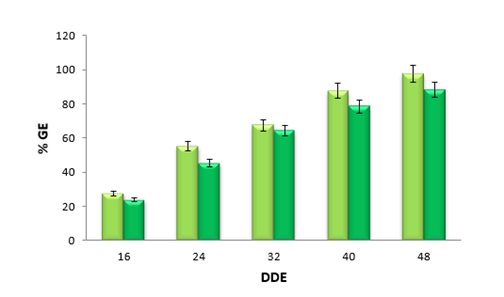
I 5 percent error bars
Figure 2: Percentage of in vitro germination of Beaucarnea recurvata Lem. seeds in the presence of light and dark. Ligh=green with ligh, Dark= green dark.
Agitación in hydrogen peroxide (H2 O2)
The seeds stirred in H2O2 in the presence and absence of light at the beginning, presented a higher percentage of contamination (30 %), while after 24 h of stirring only 3.3 % were contaminated and those that were stirred for 48 h, were completely cleaned, free of the presence of contaminating organisms (Figure 3). In most cases, the contamination was mainly due to the presence of fungi.
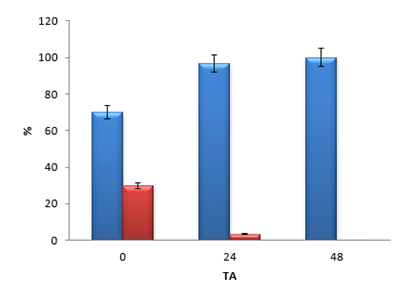
Figure 3: Percentage of contaminated and clean seeds of Beaucarnea recurvata Lem. in 0, 24 and 48 h of stirring in H2O2. Blue=clean, Red=contaminants presence.
The seeds of the treatments of 24 and 48 h in agitation in H2O2 showed a percentage of germination of 100 and 96.67, respectively; while the seeds that were not stirred in the presence of H2O2 78.26 % did not germinate; so the real percentage for this treatment was 59.9 (Figure 4); it should be noted that seeds with agitation of 24 h, germinated from 16 DDE; however, while seeds that were 48 h in stirring began to germinate a week later, but reaching almost the same percentage at 48 DDE.

I 5% error bars
Figure 4: Percentage of germination of Beaucarnea recurvata Lem. According to the stirring time in H2 O2
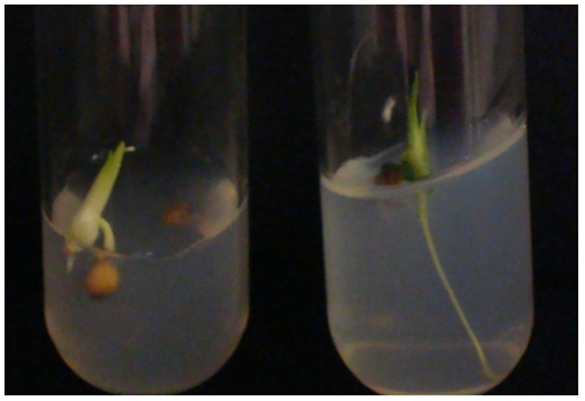
Figure 5: In vitro germination of Beaucarnea recurvata Lem seeds.
Stem tissue responses of germinated seedlings in vitro.
Type of explant
A greater number of outbreaks was obtained in the intermediate segment (I); however, there are no statistically significant differences between Intermediate (I) and Basal (B), but there are differences with respect to Terminal (Figure 6, 7 and 8). While the terminal stem tissue was the one that presented a greater length of shoots compared to the basal and intermediate showing significant difference according to the comparison de means (Table 3).

Figure 6: Promotion of sprouts of basal region (b) intermediate (i) and terminal (t) at 30 DDE in medium MS (1962) added with 10 mg· L-1 BA plus 0.3 mg· AIA L-1.
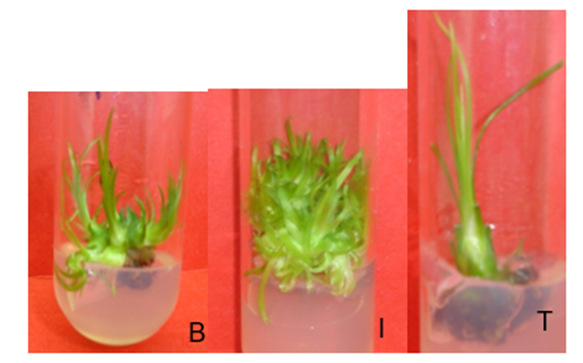
Figure 7: Sprouts obtained in basal region (B) intermediate (I) and terminal (T) at 60 DDE in medium MS (1962) added with 10 mg·L-1 BA plus 0.3 mg·L-1 AIA.
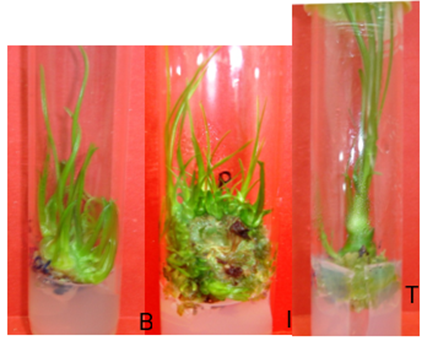
Figure 8: Promotion of sprouts in vitro of basal region (B) intermediate (I) and terminal (T) at 90 DDE in medium MS (1962) added with 10 mg·L-1 BA plus 0.3 mg·L-1AIA.
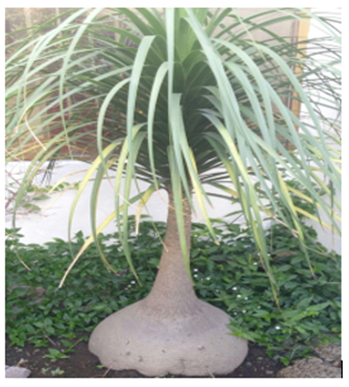
Figure 10: Plantlet of Beaucarnea recurvata establishment in soil.
Cytokinin-auxin effect.
The medium with the cytokinin-auxin 1 combination (10 mg∙L-1 BA- 0.3 mg∙L-1 AIA) was the one with the highest number of outbreaks 80 days after its establishment (Figure 8). The longer shoots were obtained in the medium with a combination of 10 mg∙L-1 2ip - 0.3 mg∙L-1 AIA; however, the results showed no significant differences between the combinations of growth regulators (Table 3).
CUADRO 3. Number and lenght of sprouts obtained according to the type or region of explants and cytokinin -auxin combination in the culture medium.
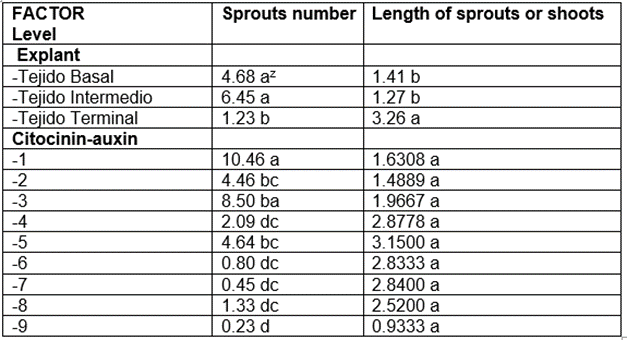
z Values with the same letter within factor in each column are equal according to Tukey's test with a P ≤ 0.05.
Establishment and in vitro germination of seeds
The works reported in Beaucarnea recurvata Lem. By Atta-Alla (2003) showed that the best responses towards germination was under light conditions, on the other hand Benítez et al. (2004) in four species of Mammilaria (Cactáceae). They showed that light was not a factor that conditioned germination, other results reported in Tillandsia eizii were between 76 and 88% seed germination (Kimberly et al., 2003). Hartman and Kester (1988) and Salisbury and Ross (1992), reported that in some species seed germination is stimulated by light; however, in other plant species germination may be inhibited; Salysbury and Ross (1992) reported that the seeds of many plant species whose light-responding seeds have not been domesticated.
Effect of hydrogen peroxide (H2 O2)
Flores (2005a) in Nolina parviflora, reported having immersed the seeds for 24 h in stirring in 3% diluted hydrogen peroxide, which did not show the presence of contaminating organisms such as fungi or bacteria, other similar cases have been reported for Abies religiosa (Alvarez et al., 2008.). In Pinus palustris Mill. and P maximartinezii (Rzedowski) the use of H2O2 in the disinfestation process also proved to be very effective, other similar results were reported to control harmful organisms, it was when commercial fungicides were used in the soaking (Barnett and McGilvary 2001, Ojeda et al., 2006). Hydrogen peroxide (H2O2), is described as an inorganic compound, which acts by oxidizing the components of the membrane and enzymes of microorganisms (Mateos, 2002 cited by Flores 2005a), because of that it has been widely used as a desinfestant for its high oxidizing power (Tom, 1998).
The results reported with seed germination by Osorio and Mata (2005). in Beaucarnea gracilis and B. recurvata, were between 89.8 and 95.3
The best disinfestation process for the establishment of in vitro seeds of B. recurvata Lem. was the application of hydrogen peroxide, under stirring for 24 and 48 hours; We can conclude that germination is not conditioned by the effect of darkness or presence of light; The periods of agitation with the effect of hydrogen peroxide for 24 hours, accelerated the times to activate seed germination. And finally, the best explants used to promote the emission of new sprouts were those isolated and sown from the intermediate and then basal region of the stems of the seeds newly germinated in vitro in the media with the inorganic salts of the MS medium and the combination of growth regulators10 mg· L-1 BA plus 0.3 mg·L-1 AIA
Clearly Auctoresonline and particularly Psychology and Mental Health Care Journal is dedicated to improving health care services for individuals and populations. The editorial boards' ability to efficiently recognize and share the global importance of health literacy with a variety of stakeholders. Auctoresonline publishing platform can be used to facilitate of optimal client-based services and should be added to health care professionals' repertoire of evidence-based health care resources.

Journal of Clinical Cardiology and Cardiovascular Intervention The submission and review process was adequate. However I think that the publication total value should have been enlightened in early fases. Thank you for all.

Journal of Women Health Care and Issues By the present mail, I want to say thank to you and tour colleagues for facilitating my published article. Specially thank you for the peer review process, support from the editorial office. I appreciate positively the quality of your journal.
Journal of Clinical Research and Reports I would be very delighted to submit my testimonial regarding the reviewer board and the editorial office. The reviewer board were accurate and helpful regarding any modifications for my manuscript. And the editorial office were very helpful and supportive in contacting and monitoring with any update and offering help. It was my pleasure to contribute with your promising Journal and I am looking forward for more collaboration.

We would like to thank the Journal of Thoracic Disease and Cardiothoracic Surgery because of the services they provided us for our articles. The peer-review process was done in a very excellent time manner, and the opinions of the reviewers helped us to improve our manuscript further. The editorial office had an outstanding correspondence with us and guided us in many ways. During a hard time of the pandemic that is affecting every one of us tremendously, the editorial office helped us make everything easier for publishing scientific work. Hope for a more scientific relationship with your Journal.

The peer-review process which consisted high quality queries on the paper. I did answer six reviewers’ questions and comments before the paper was accepted. The support from the editorial office is excellent.

Journal of Neuroscience and Neurological Surgery. I had the experience of publishing a research article recently. The whole process was simple from submission to publication. The reviewers made specific and valuable recommendations and corrections that improved the quality of my publication. I strongly recommend this Journal.

Dr. Katarzyna Byczkowska My testimonial covering: "The peer review process is quick and effective. The support from the editorial office is very professional and friendly. Quality of the Clinical Cardiology and Cardiovascular Interventions is scientific and publishes ground-breaking research on cardiology that is useful for other professionals in the field.

Thank you most sincerely, with regard to the support you have given in relation to the reviewing process and the processing of my article entitled "Large Cell Neuroendocrine Carcinoma of The Prostate Gland: A Review and Update" for publication in your esteemed Journal, Journal of Cancer Research and Cellular Therapeutics". The editorial team has been very supportive.

Testimony of Journal of Clinical Otorhinolaryngology: work with your Reviews has been a educational and constructive experience. The editorial office were very helpful and supportive. It was a pleasure to contribute to your Journal.

Dr. Bernard Terkimbi Utoo, I am happy to publish my scientific work in Journal of Women Health Care and Issues (JWHCI). The manuscript submission was seamless and peer review process was top notch. I was amazed that 4 reviewers worked on the manuscript which made it a highly technical, standard and excellent quality paper. I appreciate the format and consideration for the APC as well as the speed of publication. It is my pleasure to continue with this scientific relationship with the esteem JWHCI.

This is an acknowledgment for peer reviewers, editorial board of Journal of Clinical Research and Reports. They show a lot of consideration for us as publishers for our research article “Evaluation of the different factors associated with side effects of COVID-19 vaccination on medical students, Mutah university, Al-Karak, Jordan”, in a very professional and easy way. This journal is one of outstanding medical journal.
Dear Hao Jiang, to Journal of Nutrition and Food Processing We greatly appreciate the efficient, professional and rapid processing of our paper by your team. If there is anything else we should do, please do not hesitate to let us know. On behalf of my co-authors, we would like to express our great appreciation to editor and reviewers.

As an author who has recently published in the journal "Brain and Neurological Disorders". I am delighted to provide a testimonial on the peer review process, editorial office support, and the overall quality of the journal. The peer review process at Brain and Neurological Disorders is rigorous and meticulous, ensuring that only high-quality, evidence-based research is published. The reviewers are experts in their fields, and their comments and suggestions were constructive and helped improve the quality of my manuscript. The review process was timely and efficient, with clear communication from the editorial office at each stage. The support from the editorial office was exceptional throughout the entire process. The editorial staff was responsive, professional, and always willing to help. They provided valuable guidance on formatting, structure, and ethical considerations, making the submission process seamless. Moreover, they kept me informed about the status of my manuscript and provided timely updates, which made the process less stressful. The journal Brain and Neurological Disorders is of the highest quality, with a strong focus on publishing cutting-edge research in the field of neurology. The articles published in this journal are well-researched, rigorously peer-reviewed, and written by experts in the field. The journal maintains high standards, ensuring that readers are provided with the most up-to-date and reliable information on brain and neurological disorders. In conclusion, I had a wonderful experience publishing in Brain and Neurological Disorders. The peer review process was thorough, the editorial office provided exceptional support, and the journal's quality is second to none. I would highly recommend this journal to any researcher working in the field of neurology and brain disorders.

Dear Agrippa Hilda, Journal of Neuroscience and Neurological Surgery, Editorial Coordinator, I trust this message finds you well. I want to extend my appreciation for considering my article for publication in your esteemed journal. I am pleased to provide a testimonial regarding the peer review process and the support received from your editorial office. The peer review process for my paper was carried out in a highly professional and thorough manner. The feedback and comments provided by the authors were constructive and very useful in improving the quality of the manuscript. This rigorous assessment process undoubtedly contributes to the high standards maintained by your journal.

International Journal of Clinical Case Reports and Reviews. I strongly recommend to consider submitting your work to this high-quality journal. The support and availability of the Editorial staff is outstanding and the review process was both efficient and rigorous.

Thank you very much for publishing my Research Article titled “Comparing Treatment Outcome Of Allergic Rhinitis Patients After Using Fluticasone Nasal Spray And Nasal Douching" in the Journal of Clinical Otorhinolaryngology. As Medical Professionals we are immensely benefited from study of various informative Articles and Papers published in this high quality Journal. I look forward to enriching my knowledge by regular study of the Journal and contribute my future work in the field of ENT through the Journal for use by the medical fraternity. The support from the Editorial office was excellent and very prompt. I also welcome the comments received from the readers of my Research Article.

Dear Erica Kelsey, Editorial Coordinator of Cancer Research and Cellular Therapeutics Our team is very satisfied with the processing of our paper by your journal. That was fast, efficient, rigorous, but without unnecessary complications. We appreciated the very short time between the submission of the paper and its publication on line on your site.

I am very glad to say that the peer review process is very successful and fast and support from the Editorial Office. Therefore, I would like to continue our scientific relationship for a long time. And I especially thank you for your kindly attention towards my article. Have a good day!

"We recently published an article entitled “Influence of beta-Cyclodextrins upon the Degradation of Carbofuran Derivatives under Alkaline Conditions" in the Journal of “Pesticides and Biofertilizers” to show that the cyclodextrins protect the carbamates increasing their half-life time in the presence of basic conditions This will be very helpful to understand carbofuran behaviour in the analytical, agro-environmental and food areas. We greatly appreciated the interaction with the editor and the editorial team; we were particularly well accompanied during the course of the revision process, since all various steps towards publication were short and without delay".

I would like to express my gratitude towards you process of article review and submission. I found this to be very fair and expedient. Your follow up has been excellent. I have many publications in national and international journal and your process has been one of the best so far. Keep up the great work.

We are grateful for this opportunity to provide a glowing recommendation to the Journal of Psychiatry and Psychotherapy. We found that the editorial team were very supportive, helpful, kept us abreast of timelines and over all very professional in nature. The peer review process was rigorous, efficient and constructive that really enhanced our article submission. The experience with this journal remains one of our best ever and we look forward to providing future submissions in the near future.

I am very pleased to serve as EBM of the journal, I hope many years of my experience in stem cells can help the journal from one way or another. As we know, stem cells hold great potential for regenerative medicine, which are mostly used to promote the repair response of diseased, dysfunctional or injured tissue using stem cells or their derivatives. I think Stem Cell Research and Therapeutics International is a great platform to publish and share the understanding towards the biology and translational or clinical application of stem cells.

I would like to give my testimony in the support I have got by the peer review process and to support the editorial office where they were of asset to support young author like me to be encouraged to publish their work in your respected journal and globalize and share knowledge across the globe. I really give my great gratitude to your journal and the peer review including the editorial office.

I am delighted to publish our manuscript entitled "A Perspective on Cocaine Induced Stroke - Its Mechanisms and Management" in the Journal of Neuroscience and Neurological Surgery. The peer review process, support from the editorial office, and quality of the journal are excellent. The manuscripts published are of high quality and of excellent scientific value. I recommend this journal very much to colleagues.

Dr.Tania Muñoz, My experience as researcher and author of a review article in The Journal Clinical Cardiology and Interventions has been very enriching and stimulating. The editorial team is excellent, performs its work with absolute responsibility and delivery. They are proactive, dynamic and receptive to all proposals. Supporting at all times the vast universe of authors who choose them as an option for publication. The team of review specialists, members of the editorial board, are brilliant professionals, with remarkable performance in medical research and scientific methodology. Together they form a frontline team that consolidates the JCCI as a magnificent option for the publication and review of high-level medical articles and broad collective interest. I am honored to be able to share my review article and open to receive all your comments.

“The peer review process of JPMHC is quick and effective. Authors are benefited by good and professional reviewers with huge experience in the field of psychology and mental health. The support from the editorial office is very professional. People to contact to are friendly and happy to help and assist any query authors might have. Quality of the Journal is scientific and publishes ground-breaking research on mental health that is useful for other professionals in the field”.

Dear editorial department: On behalf of our team, I hereby certify the reliability and superiority of the International Journal of Clinical Case Reports and Reviews in the peer review process, editorial support, and journal quality. Firstly, the peer review process of the International Journal of Clinical Case Reports and Reviews is rigorous, fair, transparent, fast, and of high quality. The editorial department invites experts from relevant fields as anonymous reviewers to review all submitted manuscripts. These experts have rich academic backgrounds and experience, and can accurately evaluate the academic quality, originality, and suitability of manuscripts. The editorial department is committed to ensuring the rigor of the peer review process, while also making every effort to ensure a fast review cycle to meet the needs of authors and the academic community. Secondly, the editorial team of the International Journal of Clinical Case Reports and Reviews is composed of a group of senior scholars and professionals with rich experience and professional knowledge in related fields. The editorial department is committed to assisting authors in improving their manuscripts, ensuring their academic accuracy, clarity, and completeness. Editors actively collaborate with authors, providing useful suggestions and feedback to promote the improvement and development of the manuscript. We believe that the support of the editorial department is one of the key factors in ensuring the quality of the journal. Finally, the International Journal of Clinical Case Reports and Reviews is renowned for its high- quality articles and strict academic standards. The editorial department is committed to publishing innovative and academically valuable research results to promote the development and progress of related fields. The International Journal of Clinical Case Reports and Reviews is reasonably priced and ensures excellent service and quality ratio, allowing authors to obtain high-level academic publishing opportunities in an affordable manner. I hereby solemnly declare that the International Journal of Clinical Case Reports and Reviews has a high level of credibility and superiority in terms of peer review process, editorial support, reasonable fees, and journal quality. Sincerely, Rui Tao.
